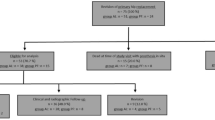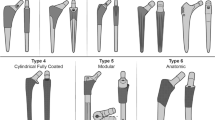Purpose
Long, cementless, femoral stem revisions are being used with increasing frequency. There is a relative lack of studies of late fractures after cementless implants, particularly in those patients who had a previous stem revision and are at higher risk for periprosthetic fracture after revision. In this paper, we review risk factors for periprosthetic fracture and revisions of long, cementless, locked stems and report implant survival compared with conventional, cemented, long-stem hip revision arthroplasties in such a group of patients.
Methods
We used data recorded in our institution. Between 1996 and 2002, 85 cementless femoral stem Aura™ (distal locked stem) prostheses were implanted in 85 patients. Of the 85 revisions with long, cementless stems, 32 were performed after one stem revision, 20 after two stem revisions and 12 after three stem revisions. Between 2003 and 2010, 124 femoral revision stems were performed in 124 patients using an extensively long, titanium femoral stem (Ceraver Osteal™). Kaplan-Meier analysis was used to determine implant survival. The Cox regression model was used to study risk factors for reoperation and revision.
Results
The increase in stem length corresponded to a mean of 4.5 ± 2.1 femoral canal diameters and was not significantly different (p = 0.02) between the two groups. Cardiopulmonary distress, intraoperative or postoperative complications were not significantly different between the two groups. There was an overall increased risk of pain, periprosthetic fractures and revision for the cementless prostheses compared with the cemented stems. With regard to thigh pain at the last follow-up, most patients (95 %) reported no pain in the cemented group, while 15 % of the cementless group experienced thigh pain under stress and 6 % had incapacitating pain. In the cemented group, stem re-revision was not required in any hip; there was no periprosthetic fracture; five stems had radiological loosening but in the absence of pain were not revised. Among patients of the cementless group, 21 % sustained failure or revision of their interlocked stem with periprosthetic fractures observed in 15 cases; factors which contributed significantly to a higher risk of fracture included the number of previous revisions; the average time between surgery and failure was 3.2 years after one revision, 2.8 years after two revisions, and 1.6 years after three revisions.
Conclusions
The long, cementless, locked stem showed more early complications compared with recementing of long-stem prosthesis. We therefore recommend the use of cemented long stems in patients with severe bone loss and previous revision.


Similar content being viewed by others
References
Fink B, Grossmann A, Schubring S, Schulz MS, Fuerst M (2009) Short-term results of hip revisions with a curved cementless modular stem in association with the surgical approach. Arch Orthop Trauma Surg 129:65–73
Garbuz DS, Masri BA, Duncan CP (1998) Periprosthetic fractures of the femur: principles of prevention and management. Instr Course Lect 47:237–242
Gie GA, Linder L, Ling RS, Simon JP, Slooff TJ, Timperley AJ (1993) Impacted cancellous allografts and cement for revision total hip arthroplasty. J Bone Joint Surg Br 75:14–21
Gosens T, van Langelaan EJ (2005) Clinical and radiological outcome of hydroxyapatite-coated femoral stem in revision hip arthroplasty. Int Orthop 4:219–223
Howie DW, Wimhurst JA, McGee MA, Carbone TA, Badaruddin BS (2007) Revision total hip replacement using cemented collarless double-taper femoral components. J Bone Joint Surg Br 89:879–886
Hultmark P, Karrholm J, Stromberg C, Herberts P, Mose CH, Malchau H (2000) Cemented first-time revisions of the femoral component: prospective 7–13 years follow-up using second generation and third-generation technique. J Arthroplast 15:551–561
Malhotra R, Dua A, Kiran EK, Bhan S (2007) Femoral revision using long hydroxyapatite-coated interlocking stem. Arch Orthop Trauma Surg 128:355–362
Courpied JP, Postel M (1989) Allogreffes massives pour reconstruction de la diaphyse fémorale. Rev Chir Orthop 75(Suppl 1):53–54
Vastel L, Lemoine CT, Kerboull M, Courpied JP (2007) Structural allograft and cemented long-stem prosthesis for complex revision hip arthroplasty: use of a trochanteric claw plate improves final hip function. Int Orthop 6:851–857
Berry DJ (2003) Periprosthetic fractures associated with osteolyis: a problem on the rise. J Arthroplasty 18:107–111
Kelley SS (1994) Periprosthetic femoral fractures. J Am Acad Orthop Surg 2:164–172
Lewallen DG, Berry DJ (1998) Periprosthetic fracture of the femur after total hip arthroplasty: treatment and results to date. Instr Course Lect 47:243–249
Lindahl H, Eisler T, Oden A et al (2006) Risk factors associated with the late periprosthetic femoral fracture. In: Lindahl H (ed) The periprosthetic femur fracture: a study from the Swedish National Hip Arthroplasty Register. Department of Orthopaedics, Sahlgenska Academy, Goteberg University, Goteberg
Lindahl H, Garellick G, Regner H et al (2006) Three hundred and twenty-one periprosthetic femoral fractures. J Bone Joint Surg Am 88:1215–1222
Lindahl H, Malchau H, Herberts P, Garellick G (2005) Periprosthetic femoral fractures: classification and demographics of 1049 periprosthetic femoral fractures from the swedish national Hip arthroplasty register. J Arthroplasty 20:857–865
Yamada H, Yoshihara Y, Henmi O, Morita M, Shiromoto Y, Kawano T, Kanaji A, Ando K, Nakagawa M, Kosaki N, Fukaya E (2009) Cementless total hip replacement: past, present, and future. J Orthop Sci 14:228–241
Wu CC, Au MK, Wu SS, Lin LC (1999) Risk factors for postoperative femoral fracture in cementless hip arthroplasty. J Formos Med Assoc 98:190–194
Della Valle CJ, Paprosky WG (2004) The femur in revision total hip arthroplasty evaluation and classification. Clin Orthop Relat Res 420:55–62
Pitto RP, Schramm M, Hohmann D, Kossler M (1999) Relevance of the drainage along the linea aspera for the reduction of fat embolism during cemented total hip arthroplasty. A prospective, randomized clinical trial. Arch Orthop Trauma Surg 119:146–150
Nich C, Sedel L (2006) Bone substitution in revision hip replacement. Int Orthop 30:525–531
Boisgard S, Moreau PE, Tixier H, Levai JP (2001) Reconstruction osseuse, inégalité de longueur des membres, taux de luxation de 52 prothèses de Wagner, en révision d’arthroplasties totales de hanche au recul moyen de 44 moi. Rev Chir Orthop 87:147–154
Bohm P, Bischel O (2001) Femoral revision with the Wagner SL revision stem: evaluation of 129 revisions followed for a mean of 4.8 years. J Bone Jt Surg Am 83:1023–1031
Vives P, Plaquet JL, Leclair A, Blejwas D, Filloux JF (1992) Tige de reprise verrouillée pour descellement des prothèses totales de hanche. Conception. Résultats préliminaires. Acta Orthop Belg 59:28–35
Kavanagh BF, Ilstrup DM, Fitzgerald RH Jr (1985) Revision total hip arthroplasty. J Bone Joint Surg Am 67:517–526
Kavanagh BF (1992) Femoral fractures associated with total hip arthroplasty. Orthop Clin North Am 23:249–257
Sarvilinna R, Huhtala HS, Sovelius RT et al (2004) Factors predisposing to periprosthetic fracture after hip arthroplasty: a case–control study. Acta Orthop Scand 75:16–20
Callaghan JJ, Salvati EA, Pellicci PM, Wilson PD Jr, Ranawat CS (1985) Results of revision for mechanical failure after cemented total hip replacement, 1979–1982. A 2–5 year follow-up. J Bone Joint Surg Am 67:1074–1085
Sierra RJ, Charity J, Tsiridis E, Timperley JA, Gie GA (2008) The use of long cemented stems for femoral impaction grafting in revision total hip arthroplasty. J Bone Joint Surg Am 90:1330–1336
So K, Kuroda Y, Matsuda S, Akiyama H (2013) Revision total hip replacement with a cemented long femoral component: minimum 9-year follow-up results. Arch Orthop Trauma Surg 133:869–874
Mann KA, Ayers DC, Damron TA (1997) Effects of stem length on mechanics of the femoral hip component after cemented revision. J Orthop Res 15:62–68
Retpen JB, Jensen JS (1993) Risk factors for recurrent aseptic loosening of the femoral component after cemented revision. J Arthroplast 8:471–478
Hamadouche M, Boutin P, Daussange J, Bolander ME, Sedel L (2002) Alumina-on-alumina total hip arthroplasty: a minimum 18.5-year follow-up study. J Bone Joint Surg Am 84(A):69–77
Hinrichs F, Kuhl M, Boudriot U, Griss P (2003) A comparative clinical outcome evaluation of smooth (10–13 year results) versus rough surface finish (5–8 year results) in an otherwise identically designed cemented titanium alloy stem. Arch Orthop Trauma Surg 123:268–72
Mertl P, Philippot R, Rosset P, Migaud H, Tabutin J, Van de Velde D (2011) Distal locking stem for revision femoral loosening and peri-prosthetic fractures. Int Orthop 35:275–282
Weiss RJ, Stark A, Karrholm J (2011) A modular cementless stem versus cemented long-stem prostheses in revision surgery of the hip: a population-based study from the Swedish Hip Arthroplasty Register. Acta Orthop 82:136–142
Author information
Authors and Affiliations
Corresponding author
Rights and permissions
About this article
Cite this article
Philippe, H., Nicolas, D., Jerome, D. et al. Long, titanium, cemented stems decreased late periprosthetic fractures and revisions in patients with severe bone loss and previous revision. International Orthopaedics (SICOT) 39, 639–644 (2015). https://doi.org/10.1007/s00264-014-2528-2
Received:
Accepted:
Published:
Issue Date:
DOI: https://doi.org/10.1007/s00264-014-2528-2




